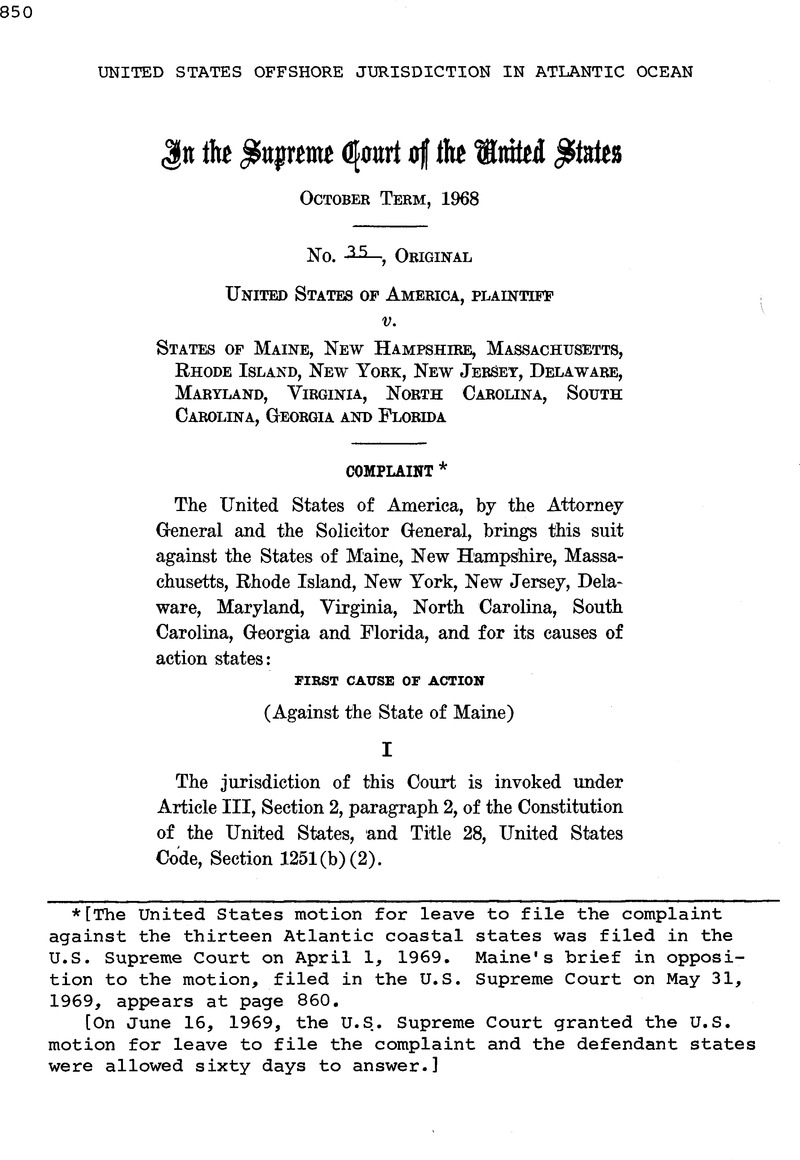No CrossRef data available.
Article contents
United States Offshore Jurisdiction in Atlantic Ocean*
Published online by Cambridge University Press: 20 March 2017
Abstract

- Type
- Judicial and Similar Proceedings
- Information
- Copyright
- Copyright © American Society of International Law 1969
Footnotes
[The United States motion for leave to file the complaint against the thirteen Atlantic coastal states was filed in the U.S. Supreme Court on April 1, 1969. Maine’s brief in opposition to the motion, filed in the U.S. Supreme Court on May 31, 1969, appears at page 860.
[On June 16, 1969, the U.S. Supreme Court granted the U.S. motion for leave to file the complaint and the defendant states were allowed sixty days to answer.]
References
1 Section 4 of the Submerged Lands Act, 43 U.S.C. 1312, confirmed the boundary of each of the original States as a line three geographical miles distant from its coast line, and approved and confirmed past or future claims to that distance by other States.
2 Eleven of the thirteen proposed defendants are original States. Maine and Florida, of course, are not, but the same principle governs their claims, as it did the claims of California, Louisiana and Texas, by virtue of the Equal Footing Clause. See, particularly, United States v. Texas, 339 U.S. 707, 717-720.
3 See, e.g., these statements made during the debates on the Sub-merged Lands Act, regarding ascertainment of the location of State boundaries for the purposes of the Act:
Senator Cordon (in charge of the bill): “That question can be determined and should be determined in 1 or 2 ways, either by agreement through a resolution adopted by the Legislature of the State of Florida and by Congress, or by a decision of the Supreme Court of the United States.” 90 Cong. Rec. 2621.
Senator Holland: ‘“The committee decided, wisely, I believe * * * that if there is a dispute as to where the boundary of a State runs, it will necessarily require legal determination and decision by the United States Supreme Court * * *” 99 Cong. Rec. 2621.
Senator Douglas: “The Supreme Court will have to move within the language of the joint resolution * * * “ 99 Cong. Rec 2896.
Senator Long: “* * * The Senator from Illinois has expressed such admiration for the Supreme Court that I would not think he would hesitate to leave that question to the Court.” 99 Cong. Rec. 2896.
Senator ANDERSONS “* * * But I say that is a matter the Supreme Court will have to settle, and those are questions which must be handled by the Supreme Court.” 99 Cong. Rec. 3037.
4 After the width of the State’s marginal belt is determined, any factual dispute regarding its location on the ground can appropriately be made the subject of supplemental proceedings before a special master, as in United States v. California, 332 U.S. 19.
5 We have included Florida as a proposed defendant with respect to its claims in the Atlantic Ocean only’(which, in our view, encompasses any claim to the submerged lands of the Florida Straits on the southern side of the Florida keys). That State’s claims in the Gulf of Mexico were, of course, determined in 1960, in United States v. Florida, 363 U.S. 121, decree sub nom. United States v. Louisiana et al., 364 U.S. 502. But Florida’s claims in the Atlantic Ocean, although placed at issue in that proceeding (see Amended Complaint filed by the United States and Answer filed by Florida in No. 11, Original, O.T. 1957), have never been adjudicated. While these issues can of course be decided in supplementary proceedings in that case (now No. 9, Original), it would seem more appropriate to join Florida as a party to this action, where the general question of State claims in the submerged lands underlying the Atlantic Ocean will be resolved.
* [The brief of the State of Maine was filed in the U.S. Supreme Court on May 31, 1969.
[The U.S. complaint and brief in support of motion for leave to file complaint appear at page 850.]




